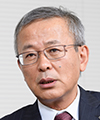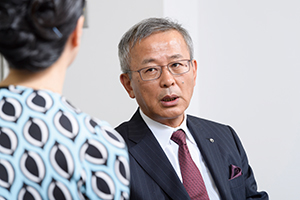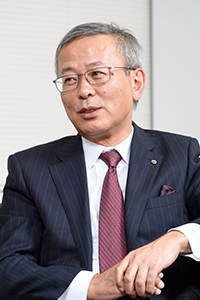 |
|||||||||||
|
|
|||||||||||
|
View from the Top Vol. 15, No. 1, pp. 1–5, Jan. 2017. https://doi.org/10.53829/ntr201701tp1  Multiplying All Opportunities and Ideas in Diverse Fields and TechnologiesOverviewThe combined concept of self-transformation and profit growth is gaining momentum in the NTT Group. Based on the B2B2X (business-to-business-to-X) model, the Group is pursuing collaboration with a wide variety of players while taking up important themes such as overcoming social problems and strengthening industrial competitiveness. We asked Hiromichi Shinohara, NTT Senior Executive Vice President, to tell us about the aspirations of the NTT Group for this year and the outlook toward 2020, which is only three years away. Keywords: B2B2X, artificial intelligence, hitoe Creating a revolution through collaboration—Mr. Shinohara, please tell us about this year’s goals. I consider 2016 to have been the year in which the B2B2X (business-to-business-to-X) model began to take shape in the NTT Group. I would therefore like to expand upon this model in 2017. In last year’s B2B2X business, what made me feel our strength the most was our ability to achieve a multiplying effect both inside and outside the company in terms of expanding our business. We achieved this effect not only with outside business partners, but also with the technologies of both the NTT laboratories and the NTT business companies within the NTT Group. We also achieved a variety of multiplying effects among projects within the NTT laboratories. In short, 2016 was a year in which new mechanisms demonstrating the strength of the NTT Group began to evolve just about everywhere. To give some concrete examples, we have undertaken the standardization of technologies for the FANUC Intelligent Edge Link and Drive system (FIELD system) developed by FANUC Corporation [1]. In this case, we were able to propose new value to FANUC by multiplying the value, achievements, and know-how of the NTT Group, such as the increasingly popular edge computing technologies from the NTT laboratories, application development technologies from NTT DATA, and operations technologies from NTT Communications (NTT Com). We have also concluded a partnership agreement with KUBOTA Corporation in relation to their infrastructure solutions for agricultural, water, and environmental management with the aim of creating new value for their customers by multiplying NTT’s research and development (R&D) achievements and the features of eight NTT Group companies including NTT Com, JSOL, and HALEX [2]. In this way, by extracting and multiplying the strengths and features of each NTT Group company while sharing major objectives, I believe that we can become an even stronger enterprise that can contribute to the prosperity of a wide variety of customers. In addition to the above, we have also set our sights on merging traditional arts such as Japanese kabuki with information and communication technology (ICT), as unusual as that might seem [3]. When viewing ICT as systems, functions, and services, it’s easy to imagine the forms that it can take. When using ICT in the world of traditional arts, however, it may be difficult to identify or imagine. To further enhance the value of traditional arts and to make them more accessible to a broad audience, we have been deepening our knowledge of how best to use ICT with the traditional arts and searching out effective methods in consultation with various partners. —The power of multiplying seems to increase all the more by interconnecting a variety of industries. I believe that there are many fields in addition to the ones I just mentioned in which we can make good use of ICT through this multiplying effect, and I want to expand into those fields from here on. To this end, we need to clarify how best to combine the strengths in the NTT Group when collaborating with key players in industry. What we cannot forget here is the value that lies in close collaboration within the NTT Group. A typical example of collaboration within the NTT Group can be found in the field of artificial intelligence (AI). To accelerate development in this field, the NTT Group launched its corevoTM initiative last year to leverage its wide array of AI-related technologies nurtured by R&D [4]. The reasoning behind setting up corevo as a group-wide brand was to prevent the generation of dispersed losses that occur through separate efforts (wasted development expenses, slow development, etc.) and to pursue enhanced convenience for customers above anything else. NTT Group companies have been using corevo to expand and study services. NTT EAST, for example, has begun to offer cloud-type robot services in the field of nursing care in cooperation with a robot manufacturer. In addition, NTT WEST has begun field trials of Smart HIKARI Golf that uses “hitoe” wearable sensing fabric [5] to analyze a golfer’s biological data such as heart beat during play and to visualize the player’s mental state. NTT Com, meanwhile, has succeeded in automatically detecting dangerous automobile driving using AI and has begun studies on commercializing this technology. Moreover, NTT DOCOMO has been performing joint experiments with the Tokyo Musen Cooperative Association on making taxi dispatching more efficient by providing drivers with taxi-use demand prediction data for 30 minutes out. NTT DATA, for its part, has begun to provide an anomaly noise detection solution to support anomaly detection and preventive maintenance in industrial fields by visualizing the operating sounds of equipment and devices using Internet of Things technology. The NTT laboratories are also playing a major role in the NTT Group’s expansion into diverse fields. In the field of retail, joint experiments have begun with 7-Eleven convenience stores on a mechanism for obtaining product information by simply pointing a smartphone over a display case. Additionally, thanks to revision of Japan’s Pharmaceuticals and Medical Devices Act (governing the quality, effectiveness, and safety of drugs/medicines and medical devices), “hitoe” has begun to be applied for the measurement of user electrocardiograms as a medical device. In the above ways, we are achieving a multiplying effect in a wide range of fields. At the risk of repeating myself, I would like to magnify this multiplying effect in even more fields in 2017 and thereby raise the morale and spirit of everyone in the NTT Group. When thinking about ICT of the future, we can be sure that collecting data of value and sharing and using it throughout Japan will be of great importance. By applying this multiplying effect to data having all kinds of value in all sorts of fields, I would like to create things of even more value that can be of great use in society and bring joy to many people.
Creating value with ICT to enhance stadium business and athlete empowerment—The major sporting event coming to Japan is only three years away. How are you planning for this event and for business expansion beyond? Yes, we of course have initiatives related to the big event of 2020, which we can divide into three main endeavors. The first is welcoming and providing hospitality services to the great number of people that will be coming to Japan from abroad. The second relates to viewing games and events and to athlete empowerment. And last but not least, the third is to create a legacy beyond 2020. First, to become a good host to foreign visitors, the most important thing is to create and provide convenient and easy-to-use services. The demand for services related to tourism in general has been addressed by government policies too, so we would like to roll out services not simply for the 2020 event but also with a view to aiding all foreign tourists coming to Japan in 2020 and into the future. Second, in terms of viewing games and events, we want to provide services that promote a sense of enjoyment that is different from anything in the past. In the United States, which can be called an advanced country in the business of sports and stadium operations, the watching and enjoying of professional sports has itself become a business. In Japan, meanwhile, sport is more closely associated with the concept of an athlete working hard and going all out to win. With this in mind, we can consider novel services that can revolutionize the stadium business. For example, spectators purchasing premium tickets could be provided with an ultra-realistic space to enable viewing from the viewpoint of an athlete, while spectators in general seats could be provided with 3D (three-dimensional) athlete-related information on handheld terminals such as smartphones. Additionally, for people who live far away from stadiums, it should be possible to construct viewing environments that everyone can enjoy, such as by offering a highly realistic viewing style at remote venues. Next, there are still many challenges ahead when it comes to athlete empowerment. There is a group at the NTT laboratories working in brain science, so we can envision athlete training using virtual reality systems and products using “hitoe” fabric that feed the results of measuring and analyzing biological data back to the athlete. In short, we would do well to take up athlete empowerment by providing a supportive environment for sports brain science and athlete training that includes actual collaboration between top-performing players and team staff. Finally, as to our third endeavor, we attach great importance to developing a robust NTT business toward 2020 that is not simply a passing phenomenon but something that can be passed on to future generations as a legacy of the NTT Group. Here, it is important that everything we undertake on the occasion of the 2020 event be connected to future projects as legacy accomplishments, such as overcoming the language barrier with the many foreign visitors that will be coming to Japan and providing barrier-free environments for visitors with various types of disabilities. Fortunately, 2020 as a milestone year provides us with a great opportunity to progress beyond the ICT field together with the entire country through a common sense of time along the same time axis. However, whether this three-year span till 2020 is just a short-distance sprint or a long-distance run probably differs from person to person, but for us, it feels more like a short-distance sprint with the feeling of “Time’s running out!” I therefore want to work toward our goals while taking a good look as to what hurdles remain from a technical point of view and how we can construct a structure that can be profitable even after 2020 from a business point of view.
Value created together is for the whole country. Make an effort to raise one’s own value.—What kind of mental attitude is needed to get results when trying to achieve a multiplying effect in diverse fields? First, with respect to collaboration with a variety of companies and enterprises, I think that nothing will happen until we give it a try. When searching for a partner, both parties may have a sense of “This is it!” when first meeting, and may begin working with each other immediately. In other cases, the other party may have to be persuaded to do something together. While it is necessary to secure a profit for the NTT Group in the short term, it is also important to create new value through collaboration with a variety of partners instead of working to maximize our profit from the very beginning. When the “B” in the middle of “B2B2X” turns out to be multiple companies instead of one, I believe that the multiplying effect of working with those companies will give rise to new value. Furthermore, it’s important that we believe strongly that such new value will be of benefit to Japan in the future. While not everything may go well at first, the key is whether a multiplying effect can eventually be achieved with partners that have the same dream and mindset as us. Choosing partners with the same objective in mind can result in a good relationship with common goals over the long term. Unfortunately, there are also times when the result of “multiplying” is simply zero. When working on a collaborative relationship, my advice is to keep track of the tide at all times and be willing to withdraw if conditions deteriorate. Upper management as well must periodically assess the true worth of collaboration.
A big welcome to people who can take a big leap, people with great dreams, and people unafraid of a challenge!—Mr. Shinohara, can you leave a message for NTT researchers? I think people doing R&D take great pleasure in leaving a big footprint in society. In this regard, I would like you to write papers of exceptional value. Furthermore, in contrast to simply producing things for society, I would like you to aim for things that can spread throughout society and bring great changes to the way that we live. That is, I would like you to take on big challenges as researchers; please attempt things that even corporate management cannot understand. Take a big leap and show us a world beyond our imagination. My biggest wish is to see all of you take up your daily work with an adventurous attitude and a look of excitement in your eyes. If you should fail or have a difficult time, please feel free to consult with me anytime. —Finally, what would you like to say to all NTT Group employees? In the same way, I would like everyone at the NTT Group to have big dreams and pursue challenging work. I would also like each of you to have your own set of principles and evaluation criteria to make sound judgments. Instead of doing something just because someone said so, please think about what was said, find what goal to aim for and the best approach to take, and act according to your own will. If you execute something in the way that someone specified, you will not be able to transcend the goal established by that person. In a company, there are all kinds of managerial positions and viewpoints, but each is associated with a single human being whose knowledge and experience are, of course, limited. It is exactly for this reason that I would like you to act on your own volition while contemplating what was said so that you can leap beyond that framework. I would be happy to meet a person who thinks “outside the box” and behaves in a way that betrays my expectations in a good sense. Indeed, I have great expectations that many people will do amazing things above and beyond what I could ever imagine! References
Interviewee profileCareer highlightsHiromichi Shinohara joined Nippon Telegraph and Telephone Public Corporation (now NTT) in April 1978. In 1998, he was promoted to Vice President of the Information Sharing Laboratory Group at Access Network Service Systems Laboratories. He became Senior Vice President of the Information Sharing Laboratory Group in June 2007. In June 2009, he became a member of the Board of NTT and Head of the R&D Strategy Department. In June 2012, he became Executive Vice President and Head of the R&D Strategy Department. He took up his present position in June 2014. |
|||||||||||











